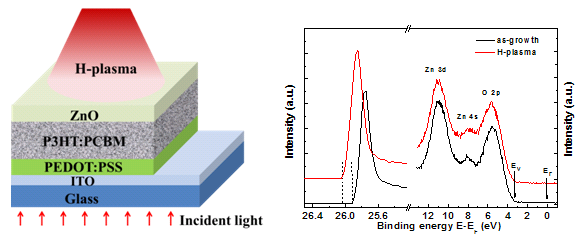| Enhanced efficiency in polymer solar cells via hydrogen plasma treatment of ZnO electron transport layers |
| From: PublishDate:2016-06-03 Hits: |
Polymer bulk heterojunction (BHJ) solar cells have broad prospect of application because of the advantages of low cost, suitable for mass-production by roll-to-roll, being mechanically flexible and light weight. However, the power conversion efficiency (PCE) of polymer BHJ solar cells still needs to be improved for commercial application. A team from Key Lab of Semiconductor Materials Science in Chinese Academy of Sciences has demonstrated that hydrogen plasma (H-plasma) treatment of ZnO electron transport layers (ETL) is an effective way to enhance the PCE of polymer BHJ solar cells. Their research has been published on November 18rd, 2014 in Journal of Materials Chemistry A. ZnO has been regarded as one of the most promising ETL due to the advantages of high electron mobility, good transparency and low work function. The work function of ZnO is about 3.99-4.5 eV, and it matches well with the energy level of electron donors and cathodes in BHJ solar cells. In previous work of the team, they found that the H-plasma can enhance the conductivity of ZnO films, improve their transmittance, and reduce their work function. Therefore, it can be predicted that the PCE can be improved effectively via H-plasma treatment of ZnO ETL. However, there has been no report concerning improving the PCE of BHJ solar cells via H-plasma treatment of ZnO ETL. The team systemically investigated the effect of H-plasma treatment of ZnO ETL on the performance of BHJ solar cells for the first time. They found that the open circuit voltage (VOC) of the BHJ solar cells was dramatically improved to 0.670 V after H-plasma treatment, and the PCE of BHJ solar cells has been enhanced by 27%.
(a) Schematic of the photovoltaic device structure consisting of the following: ITO/PEDOT:PSS/P3HT:PCBM/ZnO/Al; (b) UPS spectra of the ZnO films with and without H-plasma treatment. The work function of ZnO film before H-plasma treatment is 4.13 eV, and after H-plasma treatment it reduced to 3.98 eV. The data were collected at beam line 4B9B of BSRF with the photon energy of 30 eV. Synchrotron sources helped the team to uncover the microscopic origin of the PCE enhancement. Ultraviolet photoelectron spectroscopy (UPS) measured at beam line 4B9B of Beijing Synchrotron Radiation Facility (BSRF) reveals that the secondary electron cutoff in the treated sample shifts toward a higher binding energy, indicating that H-plasma treatment reduces the work function of ZnO. The work function of ZnO can be determined from: Φ = hν – (ECutoff - EFeimi), where hν is the photon energy (30eV), EFeimi is the Fermi level, and ECutoff is the inelastic high-binding-energy cutoff, which can be extracted using a linear extrapolation of the high-binding energy cutoff region of the UPS spectra. The work functions of the ZnO flms are calculated to be 4.13 eV and 3.98 eV before and after H-plasma treatment, respectively. The reduction in ZnO work function after H-plasma treatment is attributed to the formation of surface dipoles and/or the up-shift of the Fermi level. In polymer BHJ solar cells, the VOC has a linear relationship with the HOMO (donor) – LUMO (acceptor) energy gap, and it is affected by the work function of the cathode, which can be modified by interfacial layers. Therefore, after H-plasma treatment of ZnO ETL, the VOC of polymer BHJ solar cell is enhanced from 0.612 V to 0.670 V, resulting in the PCE of the device being improved from 3.03% to 3.84%. Article: Hong Li Gao, Xing Wang Zhang,* Jun Hua Meng, Zhi Gang Yin, Liu Qi Zhang, Jin Liang Wu and Xin Liu Enhanced efficiency in polymer solar cells via hydrogen plasma treatment of ZnO electron transport layers. J. Mater. Chem. A, 2015, 3, 3719-3725 |
|
|
| Chinese
- Beamline 1W1 of BSRF started to runoperate in the couplingparasitic mode of BEPCII
- Synthesis of High Performance Polymer Materials for Field Effect-Transistors
- Surfactant molecular aggregates in green solvents
- GIXRD has played an important role in the characterization of organic thin-film transistors
Copyright © 2011 - 2012 Beijing Synchrotron Radiation Facility


